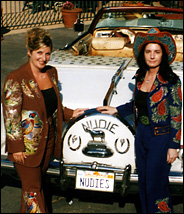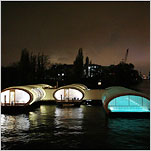NUDIE COHN might have trouble customizing cars today.

Jamie Lee Nudie, left, and Mary Lynn Cabrall with the last of the cars, a 1975 Eldorado.

One of Cohn's earliest custom cars, a 1958 Pontiac Bonneville.

Webb Pierce's Bonneville is now a top attraction at the Country Music Hall of Fame.
His six-shooter door handles would raise eyebrows at Homeland Security. (Don't even mention the rifles affixed to the trunk and fenders.) Steer horns on the hood would hardly meet pedestrian-safety standards. Hand-tooled leather saddles, placed between the front seats for young cowpokes, wouldn't pass muster as child-safe seating. Rare silver dollars, adorning nearly every surface of the interior, would surely prove too tempting for passers-by.
But when Cohn started creating his cars in the 1950's - his bang-bang Western excess may have laid the foundation for today's bling-bling sensibilities - they were cultural counterpoints at a time of conformity. It is hard to look back today and not see Cohn's style - his cars were an adjunct to a successful Western-fashion business that catered to attention-starved celebrities - as a precursor to the wild personalization of cars on the streets now. Without a Nudie, could there be Jesse James's "Monster Garage" or Xzibit's "Pimp My Ride"?
A 5-foot-7 tailor with outsize ambition and a love of the limelight, Cohn was a pioneer in making country seem cool. His life was marked by western movement, and when he went west, he truly went west: he immigrated as a child from Ukraine, started a career in New York and became famous for his store in North Hollywood. It seemed that everybody who was anybody eventually made a pilgrimage to Nudie's Rodeo Tailors.
Cohn made his mark by adorning Western-cut suits with galaxies of rhinestones, forests of fringe and symphonies of sparkling oversize G clefs. He fitted Elvis in gold lamé; created a shocking ensemble for Gram Parsons, the proto-country rocker, embellished with pills and marijuana leaves; designed hundreds of shirts for the singing cowboy, Roy Rogers; and parked a star-studded 10-gallon hat on Elton John.
Just as some of today's rockers, including Lenny Kravitz and Perry Farrell of Jane's Addiction, seek out and spend freely for original Nudie suits (and original owners like George Jones, the country star, reconnect with theirs on eBay), so are the cars objects of desire for museums, movie studios and at least one original owner.
Nudie's cars carried his personal touch, since this tireless self-promoter used them as promotional vehicles. Mostly Pontiacs, they were bedecked with silverplated guns, hand-tooled leather and hood-mounted horns. Of the original 18 cars, the whereabouts of only 9 are known, making these gun-laden land yachts among the rarest breeds of custom cruisers.
Since Cohn died in 1984, his granddaughter Jamie Lee Nudie has carried his torch - to the point of adopting his first name as her last. She has written a book about her grandfather's legacy, "Nudie the Rodeo Tailor" (Gibbs Smith, 2004), with a family friend, Mary Lynn Cabrall. The women also have a Web site, www.nudiesrodeotailor.com, with photographs, biographical information and Nudie merchandise.
It wasn't always easy to be kin to such a flamboyant figure. Ms. Nudie recalled a time in junior high, at the pinnacle of straight-haired, braces-mouthed self-consciousness, when her mother announced that she would pick up Jamie at school in what the family called the Horny Car. This was her grandfather's fantastically one-of-a-kind 1975 Cadillac Eldorado, nicknamed for the seven-foot steer horns on its hood.
"I said, 'No, Mom, not the Horny Car!' " Jamie Lee recalled. "So she pulls up alongside the school and of course, everybody is like, 'Oh my gosh, what's that?' My friend was next to me, and Mom was honking the horn, and I pretend I don't know her.
"Well, we also have a cassette tape of stampeding cows and horses, and Mom starts to play that. Then my friend is like, 'Wait a minute, isn't that your grandfather's car?' I was so embarrassed - like, how can I get into this car?"
What made her blush then is now a matter of family pride, but "in junior high, it was just not cool," she said.
In preparing their book, Ms. Nudie and Ms. Cabrall did extensive research on Cohn. He started life in 1902 in Kiev as Nuta Kotlyarenko. His father was a bootmaker to the czars; his mother raised geese and ran a theater concession stand.
At 11, amid pogroms against Jews, Nuta was sent to America with his brother, Julius. At Ellis Island, immigration officers changed Nuta's name to Nudie Cohn. After several cross-country trips, time spent shining shoes, boxing and hanging out with the gangster Pretty Boy Floyd, Nudie married Helen Kruger, whom he met while staying at her mother's boardinghouse.
The couple moved to New York, where Julius had become successful in the brassiere business, and opened a shop called Nudies for the Ladies near Times Square. Its most popular items were custom G-strings.
The Cohns moved to California in the early 40's. He worked as a tailor, and according to Ms. Nudie, persuaded Tex Williams, the cowboy musician who at the time was far from wealthy, to auction a horse and saddle to buy a $140 sewing machine. In exchange, Cohn sewed suits for Williams - on a Ping-Pong table in a garage.
In 1947, Cohn opened the store where he created elaborate shirts, suits and dresses for the likes of Hank Williams, Roy Rogers and Dale Evans. He took to driving around in a 1950 Hudson adorned with horns, and Ms. Nudie said he was popular with children because he would hand out dollar bills as he cruised by.
Manuel Cuevas, Cohn's onetime partner, former son-in-law and current Nashville country clothier, recalled that Nudie was approached in the late 1950's by Art Miller, a flamboyant car dealer and horseman. Miller, it seemed, was looking for a flashy car to promote his dealership.
Bonnevilles were the car of choice, Mr. Cuevas said, partly because they were among the longest cars on the road. "We took the seats out and did the upholstery in tooled leather," he said. "We put guns and bullets and silver dollars all over it."
Mr. Cuevas recalled that guns were cheap and easy to buy in Los Angeles. The Winchesters, Colts and derringers were sent to be plugged and silver-plated. When returned, the guns were holstered or became gearshifts and door handles. Silver dollars were strategically added.
"I thought it was fantastic," Mr. Cuevas said. "The more things we had to hang on the car, the better."
In the early 60's, for promotional purposes, Cohn began receiving a free Pontiac every year. Typically, he'd drive the cars for a while and then sell them or give them away. While Mr. Cuevas said he recalled a few going out the door at prices up to $35,000, Nudie gave his '63 Bonneville (adorned with more than 100 valuable coins, including Morgan silver dollars) to his friend Roy Rogers.
Today, that car is hooked to a Nudie-customized covered-wagon trailer in the Roy Rogers museum in Branson, Mo., not far from Trigger, the world's most famous stuffed horse. Dave Koch, a museum spokesman, said Rogers drove the car regularly near his Apple Valley, Calif., home, until souvenir hunters began prying off coins.
"It was such a long vehicle with that extended rear bumper, that it was very difficult to drive on hills," Mr. Koch said. "You had to enter driveways at a major angle."
With Nudie's cars, as with his fashions, practicality or drivability wasn't the point. Through the 60's and early 70's, his cars found their way into the hands of the country stars George Jones, Buck Owens and Webb Pierce; the Las Vegas gambling legend Benny Binion; and a swashbuckling Canadian oilman, William Herron. The Glenbow Museum in Calgary, Alberta, is negotiating with Herron's widow to acquire his Nudiemobile for its collection.
Two cars ended up in Belgium at Bobbejaanland, a Western-theme amusement park founded by Bobbejaan Schoepen, a Belgian entertainer with a passion for country music.
Recently, Ms. Nudie said, the Eldorado Horny Car was offered a role as Boss Hogg's ride in "The Dukes of Hazzard," but the family did not pursue the idea for fear the car might be damaged. Last month, she drove it to the Golden Boot Awards, a Hollywood charity event. The car will be featured in a future segment of "Antiques Roadshow."
The huge car is a handful on the road, she said, and because of all the guns it draws attention from the police. "We had a letter written by the commander of the L.A.P.D. that we actually carry in the glovebox that says this car is allowed on the roads," she said. "It's a great letter - it talks about what a wonderful man Nudie is, and how everything has been determined to be street legal. So don't write him tickets."
Several of Cohn's cars are displayed around the country, and each has a story. Gutted of its mechanical systems and displaying autographs of John Wayne, James Arness and others, a 1973 Grand Ville hangs above the bar at Buck Owens's Crystal Palace, an entertainment complex in Bakersfield, Calif.
Ms. Nudie and Mr. Owens's manager, Jim Shaw, said the car had originally been built for Elvis but that his handlers wouldn't let Cohn deliver it to the singer - perhaps out of fear that he might order a fleet of Nudiemobiles for his staff.
Mr. Shaw said Mr. Owens either bought the car or won it from Cohn in a poker game. Later, Mr. Owens bought a '72 Grand Ville by Nudie at a Texas auction for about $50,000.
In the early 1970's, George Jones, a prodigious acquirer of cars and Nudie suits, bought a Nudiemobile. His manager, Evelyn Shriver, said the purchase was "one of those crazy things he used to do- buying a car like that." But, she added, Mr. Jones didn't drive it much and it spent most of its time in his barn in Spring Hill, Tenn. Eventually, rodents took a liking to the leather, and pigeons roosted in the car. Mr. Jones eventually sold the car back to Cohn.
One Nudiemobile that remains in good condition is the 1962 Bonneville that belonged to Webb Pierce, the flashy country star who died in 1991. The car (along with Elvis's gold-plated Cadillac limousine) is in the Country Music Hall of Fame in Nashville. Mick Buck, a curator, said the Pontiac was one of the museum's biggest attractions.
Pierce's 79-year-old widow, Audrey, recalled in a telephone interview: "Webb bought the car from Nudie. I was in Arkansas visiting my folks, and he called me to describe the car. I said, 'That's the wildest car - you made the biggest mistake.' But he bought it for publicity. They had to guard the car all the time from people who wanted souvenirs."
Recently, she said, members of her church group begged her to accompany them to to see her husband's car. "There's a booth close to the car and a picture of Webb standing by it," she said wistfully. "Webb was one of the first to introduce the pedal steel guitar, and 'In the Jailhouse Now' is slowly playing there. I stood around and just looked at the car. It was a little bit much."















